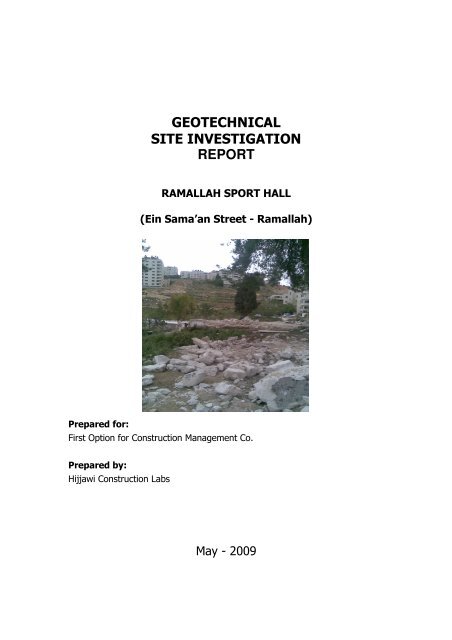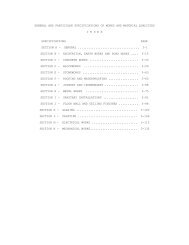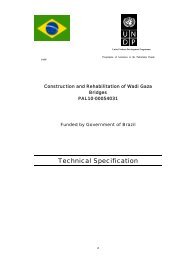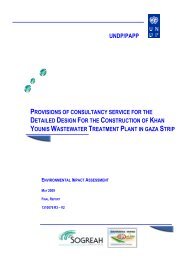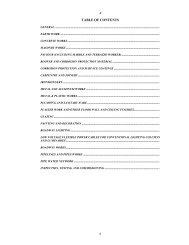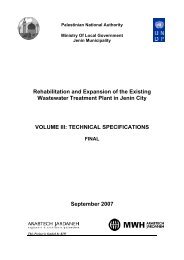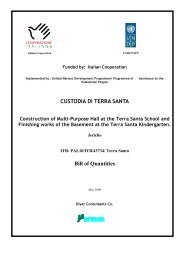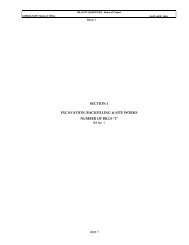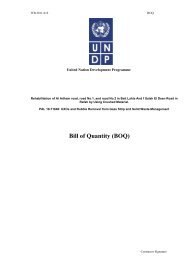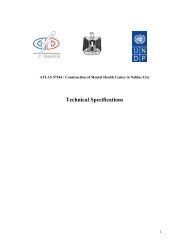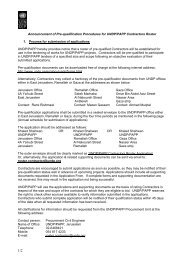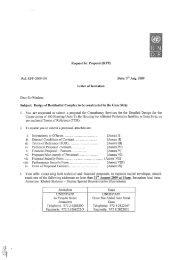GEOTECHNICAL SITE INVESTIGATION REPORT - UNDP
GEOTECHNICAL SITE INVESTIGATION REPORT - UNDP
GEOTECHNICAL SITE INVESTIGATION REPORT - UNDP
You also want an ePaper? Increase the reach of your titles
YUMPU automatically turns print PDFs into web optimized ePapers that Google loves.
<strong>GEOTECHNICAL</strong><br />
<strong>SITE</strong> <strong>INVESTIGATION</strong><br />
<strong>REPORT</strong><br />
RAMALLAH SPORT HALL<br />
(Ein Sama’an Street - Ramallah)<br />
Prepared for:<br />
First Option for Construction Management Co.<br />
Prepared by:<br />
Hijjawi Construction Labs<br />
May - 2009
Hijjawi<br />
M-s/ 1 st Option for Construction Management Co.<br />
Ramallah<br />
Ref : SI/361<br />
Date : 6/5/2009<br />
Project – Ramallah Sport Hall – Ein Sama’an Street<br />
Subject - Site Investigation Report<br />
Dear Sirs,<br />
With reference to your request (SI/361 on 29/4/2009, Hijjawi Construction Labs<br />
(HCL) is pleased to submit this report of the site investigation carried out for the<br />
proposed construction site of the above mentioned project.<br />
The investigation ended up with conclusions and recommendations relevant to the<br />
findings. Those, in addition to the laboratory test results and engineering<br />
recommendations are herewith attached.<br />
We look forward for further cooperation and would like to take this opportunity to<br />
highly considerate your confidence in our laboratories. For any clarification<br />
concerning this report, please contact us at your convenience.<br />
Yours sincerely,<br />
Dr. Sami A. Hijjawi<br />
General Manager<br />
E:\HCL\Site Invest E\ - <strong>REPORT</strong>.doc\مباني<br />
رام االله\ الصالة الرياضية
Hijjawi<br />
CONTENTS<br />
1. INTRODUCTION<br />
1.1 GENERAL<br />
1.2 PURPOSE AND SCOPE<br />
2. <strong>SITE</strong> CONDITIONS<br />
2.1 DESCRIPTION<br />
2.2 SUBSURFACE CONDITIONS<br />
2.3 GROUND WATER<br />
3. FIELD EXPLORATION AND SAMPLING<br />
3.1 DRILLING<br />
3.2 SAMPLING<br />
4. LABORATORY TESTING<br />
4.1 TESTS CARRIED OUT<br />
4.2 SUMMARY OF LABORATORY TEST RESULTS<br />
5. BEARING CAPACITY ANALYSIS<br />
6. SELECTION OF FOUNDATION TYPE<br />
7. SETTLEMENT ANALYSIS<br />
8. ENGINEERING RECOMMENDATIONS<br />
9. REFERENCES<br />
10. APPENDICES<br />
E:\HCL\Site Invest E\ - <strong>REPORT</strong>.doc\مباني<br />
رام االله\ الصالة الرياضية
Hijjawi<br />
1. INTRODUCTION<br />
1.1 GENERAL<br />
This report presents the outcome of the site investigation carried out for the<br />
proposed construction site of Ramallah Sport Hall building in Ramallah (Ein Sama’an<br />
Street).<br />
1.2 PROJECT DESCRIPTION<br />
The project consists of the construction of about 1000 m 2<br />
(sport hall).<br />
steel structure building<br />
1.3 PURPOSE AND SCOPE<br />
Investigation of the underground conditions at a site is prerequisite to the<br />
economical design of the substructure elements. It is also necessary to obtain<br />
sufficient information for feasibility and economic studies for any project.<br />
In general, the purpose of this site investigation was to provide the following:<br />
1- Information to determine the type of foundation required (shallow or deep).<br />
2- Information to allow the geotechnical consultant to make a recommendation on<br />
the allowable bearing capacity of the soil.<br />
3- Sufficient data/ laboratory tests to make settlement and swelling predictions.<br />
4- Location of the groundwater level.<br />
5- Information so that the identification and solution of excavation problems can be<br />
made.<br />
6- Information regarding permeability and compaction properties of the encountered<br />
materials.<br />
E:\HCL\Site Invest E\ - <strong>REPORT</strong>.doc\مباني<br />
رام االله\ الصالة الرياضية
Hijjawi<br />
7- Information regarding cavitations and other kinds of geological weaknesses within<br />
the construction site.<br />
This was accomplished through the close cooperation of HCL's geotechnical engineer<br />
and the technical staff of its Geotechnical Department.<br />
2. <strong>SITE</strong> CONDITIONS<br />
2.1 DESCRIPTION<br />
The site is located in Ramallah (Ein Sama’an street) at the location of the recently<br />
demolished slaughterhouse. It is bordered by roads from north, south and east as<br />
shown on the attached Figure.1<br />
No high voltage, electrical or telephone poles, sewer or water pipes were observed<br />
within the depth of the drilled boreholes.<br />
2.2 SUBSURFACE CONDITIONS<br />
The study area on the date of field investigation consisted of different elevations with<br />
approximate difference between the higher and lower elevations of about 7-8m.<br />
However, the formation within the depths of the drilled boreholes consists mostly of<br />
creamy, hard to medium hard formation of marlstone to the full depth of exploration<br />
covered by different depth fills.<br />
The drilled boreholes for this study reflect the described above general conditions.<br />
They are discussed in more detail in the subsequent sections of this report. Borehole<br />
logs with description of soil and rock formations are attached in the Appendix.<br />
2.3 GROUNDWATER AND CAVITIES<br />
Ground water was not encountered within the depths of the drilled boreholes and no<br />
ground water table was observed. No cavities or other kind of weaknesses were<br />
noticed within the drilled depths of boreholes.<br />
E:\HCL\Site Invest E\ - <strong>REPORT</strong>.doc\مباني<br />
رام االله\ الصالة الرياضية
Hijjawi<br />
3. FIELD EXPLORATION AND TESTING<br />
3.1 DRILLING<br />
Upon the Client’s request, the site investigation program included the exploration of<br />
site subsurface conditions at the construction area through the drilling of four<br />
boreholes: two to a depth of 8.0 m each and two to a depth of 5.0 m each below the<br />
existing ground level.<br />
Drilling has been carried out utilizing a truck-mounted drilling rig (Mobile Drill B-31)<br />
with the possibility of continuous sampling at different depths and at each lithological<br />
change of the strata.<br />
3.2 SAMPLING<br />
Two types of samples were collected:<br />
a- disturbed samples suitable for identification and index property testing purposes<br />
at various depths.<br />
b- undisturbed rock samples for strength tests.<br />
Representative samples were placed in sealed plastic bags and transported to the<br />
laboratory for further testing.<br />
In our opinion the obtained samples were of good quality.<br />
E:\HCL\Site Invest E\ - <strong>REPORT</strong>.doc\مباني<br />
رام االله\ الصالة الرياضية
Hijjawi<br />
4. LABORATORY TESTING<br />
Representative soil and rock samples were collected from the drilled boreholes,<br />
tightly sealed and transported to HCL's Laboratories in Nablus.<br />
4.1 TESTS CARRIED OUT<br />
The following tests were performed to evaluate the engineering properties of the<br />
soils and rocks influencing the performance of the proposed structure:<br />
1- Natural moisture contents were determined in accordance with ASTM D-<br />
2216.<br />
2- Atterberg limits (Liquid and Plastic) in accordance with ASTM D-4318.<br />
Liquid and plastic limit tests were conducted on the powder of the obtained<br />
samples and the plasticity index (PI) was determined.<br />
3- Specific gravity and absorption in accordance with ASTM C-127.<br />
4- Test for Unconfined Compressive Strength of Intact Rock Core Specimens in<br />
accordance with ASTM D-2938.<br />
5- Direct shear test in accordance with ASTM D-3080, where three identical<br />
specimens were sheared under three vertical load conditions and the maximum<br />
shear stress in each case was measured. The strength parameters, namely<br />
cohesion (c) and angle of internal friction (Ø) were determined from the<br />
maximum shear-vs- normal stress plot.<br />
The results of the mentioned above tests are summarized in tables below.<br />
E:\HCL\Site Invest E\ - <strong>REPORT</strong>.doc\مباني<br />
رام االله\ الصالة الرياضية
Hijjawi<br />
Moisture Liquid Plasticity<br />
Borehole Depth<br />
content limit Index<br />
No.<br />
(m)<br />
(%) (%) (PI)<br />
793.0-792.0 7.8 32.5 13.2<br />
1 792.0-790.0 10.9 Non plastic (NP)<br />
790.0-785.0 7.5 NP NP<br />
792.0-791.0 - - -<br />
2<br />
791.0-790.0 8.0 NP NP<br />
790.0-789.0 8.5 NP NP<br />
789.0-787.0 7.8 NP NP<br />
789.0-787.5 7.4 42.0 14.9<br />
3 787.5-786.0 7.7 NP NP<br />
786.0-781.0 7.1 NP NP<br />
787.0-786.0 5.5 - -<br />
4 786.0-784.5 9.9 NP NP<br />
784.5-782.0 7.3 NP NP<br />
Note : tests were carried out on cuttings resulted from the DTH drilling.<br />
Table (1) Summary of Test Results<br />
Borehole<br />
No.<br />
Depth<br />
(m)<br />
Specific<br />
gravity<br />
Water<br />
absorption<br />
(%)<br />
Compressive<br />
strength<br />
(Kg/cm²)<br />
1 791.5 2.333 11.5 76<br />
2 791.0 2.344 10.5 85<br />
3 787.5 2.338 10.8 82<br />
4 784.5 2.353 9.7 105<br />
Table (2) – Summary of rock properties<br />
E:\HCL\Site Invest E\ - <strong>REPORT</strong>.doc\مباني<br />
رام االله\ الصالة الرياضية
Hijjawi<br />
Borehole<br />
No.<br />
Elevation<br />
(m)<br />
Cohesion<br />
(Kg/cm²)<br />
Angle of internal<br />
friction φ (°)<br />
1 792.0-790.0 10 23<br />
2 791.0-790.0 11 24<br />
3 787.5-786.0 11 23<br />
4 784.5-782.0 8 27<br />
*Samples were collected from the cuttings resulted from drilling.<br />
Table (3) Summary of Shear Test Result<br />
5. BEARING CAPACITY ANALYSIS<br />
Two approaches were utilized to calculate the bearing capacity of the shallow<br />
bedrocks:<br />
5.1 Utilizing the bearing capacity Equations:<br />
The bearing capacity was calculated using the shear test parameters of cohesion and<br />
angle of internal friction and the soil density of the specimens extracted from the<br />
boreholes. The following well known Terzaghi equation with correction terms<br />
suggested by Schultze can be used to calculate the bearing capacity of rectangular<br />
foundation of any sides ratio B:L<br />
q ult = (1+ 0.3 B/L) CN c + γ o DN q + (1- 0.2 B/L) (γ 1 B/2) N γ<br />
where:<br />
γ o - Unit weight of soil above foundation level in KN/m³.<br />
γ 1 - Unit weight of soil below foundation level in KN/m³.<br />
C,Ø - Strength parameters of the soil below foundation level in KN/m² and degrees<br />
respectively.<br />
B - Width of foundation in (m).<br />
L - Length of foundation in (m).<br />
N c , N q , N γ - Bearing capacity coefficients dependent on the angle of internal friction<br />
E:\HCL\Site Invest E\ - <strong>REPORT</strong>.doc\مباني<br />
رام االله\ الصالة الرياضية
Hijjawi<br />
D<br />
of the soil below foundation level (dimensionless).<br />
- Depth of foundation (m).<br />
Calculations for an assumed isolated footing :<br />
Considering:<br />
B = 2.5m<br />
L = 2.5m<br />
D = 2.0m<br />
γ o = 22 KN/m³<br />
γ 1 = 22 KN/m³<br />
C = 10 KN/m²<br />
Ø = 23 º<br />
The bearing capacity was computed using a special computer program following<br />
Terzaghi method. The sheet with computations is attached. Based on the<br />
calculations, a bearing capacity of 363 KPa is given at a depth of not less than<br />
2.0m from the original ground assuming isolated footings will be utilized.<br />
5.2 Utilizing the Code Instructions:<br />
According to the known codes of engineering practice, the bearing capacity of rocks<br />
is taken as a percentage of the unconfined compressive strength of rock core<br />
samples tested in accordance with ASTM D-2938.<br />
Following the Jordanian Code for Foundations and Retaining Walls (Amman- 1992)<br />
[§3/7/1-2], the mentioned percentage is 5% for rocks with RQD ≤ 25 % and the<br />
bearing capacity should not exceed 10 Kg/cm².<br />
Taking the lowest compressive strength value of rock core specimens from the table<br />
(2) with test results above and applying the percentage of 5%, the strength will be:<br />
Q all = 5 % x 76 = 3.8 Kg/cm²<br />
E:\HCL\Site Invest E\ - <strong>REPORT</strong>.doc\مباني<br />
رام االله\ الصالة الرياضية
Hijjawi<br />
BEARING CAPACITY OF SHALLOW FOUNDATIONS<br />
Terzaghi Method<br />
Date May 6, 2009<br />
Identification Ramallah Sport Hall<br />
BEARING CAPACITY OF SHALLOW FOUNDATIONS<br />
Terzaghi and Vesic Methods<br />
Date May 6, 2009<br />
Identification Ramallah Sport Hall<br />
Input<br />
Results<br />
Units of Measurement<br />
Terzaghi<br />
SI SI or E<br />
Bearing Capacity<br />
Foundation Information q a = 363 kPa<br />
Shape<br />
SQ<br />
SQ, CI, CO, or<br />
RE<br />
B = 2.5 m Allowable Column Load<br />
L = 2.5 m P = 2,268 kN<br />
D =<br />
2 m<br />
Soil Information<br />
c =<br />
10 kPa<br />
phi =<br />
25 deg<br />
gamma =<br />
22 kN/m^3<br />
Dw =<br />
20 m<br />
Factor of Safety<br />
F = 3<br />
6. SELECTION OF FOUNDATION TYPE<br />
According to the nature and characteristics of the materials encountered in the<br />
drilled boreholes as described in § 2.2 (hard to medium hard marlstone), we<br />
recommend to consider isolated footings with tie beams at any depth after<br />
cleaning all debris and loose fill materials.<br />
7. SETTLEMENT ANALYSIS<br />
With footings designed and constructed on the described above rocky formation, the<br />
settlement is negligible.<br />
E:\HCL\Site Invest E\ - <strong>REPORT</strong>.doc\مباني<br />
رام االله\ الصالة الرياضية
Hijjawi<br />
8. ENGINEERING RECOMMENDATIONS<br />
As a result of field and laboratory activities carried out and the analysis of the<br />
available data and test results, the following engineering recommendations can be<br />
made:<br />
8.1 ALLOWABLE BEARING CAPACITY<br />
According to the analysis of the materials encountered (hard to medium hard<br />
marlstone) and the laboratory test results, the recommended allowable bearing<br />
capacity is 3.5 Kg/cm² for shallow foundations assuming that foundations will rest<br />
on the described marlstone formation after cleaning of all loose inclusions.<br />
8.2 DRAINAGE OF THE <strong>SITE</strong><br />
It is recommended to design an effective rainwater drainage system to get rid of the<br />
consequences of the rainwater percolation into the layers. The site should be graded<br />
so as to direct rainwater and water away from all planned structures.<br />
8.3 MATERIALS FOR BACKFILL – COMPACTION CRITERIA<br />
Materials encountered in the drilled boreholes are satisfactory for using for backfilling<br />
purposes. In general, materials for the backfilling should be granular, not containing<br />
rocks or lumps over 15 cm in greatest dimension, free from organic matter, with<br />
plasticity index (PI) not more than 10. The backfill material should be laid in lifts not<br />
exceeding 25 cm in loose thickness and compacted to at least 95 percent of the<br />
maximum dry density at optimum moisture content as determined by modified<br />
compaction test (Proctor) (ASTM D-1557).<br />
8.4 SEISMIC CONSIDERATIONS<br />
As far as the seismic activity in the region has not witnessed any serious earthquakes<br />
in the last 70 years, the last earthquake in February 2004 in Palestine and<br />
E:\HCL\Site Invest E\ - <strong>REPORT</strong>.doc\مباني<br />
رام االله\ الصالة الرياضية
Hijjawi<br />
neighboring Middle East countries and their serious consequences made it necessary<br />
to consider a seismic precautive factor in the design of the project structures.<br />
Referring to the Unified Building Code Research in Jordan, the area can be<br />
considered within Zone B, which corresponds to an intensity of VI to VIII according<br />
to the Mercalli Scale (4-6 Richter Scale respectively).<br />
According to the seismic zoning chart prepared by An-Najah National University for<br />
Palestine (see appendix), the seismic gravity acceleration factor for area (Zone II)<br />
z = 0.12-0.15 g , where g – gravity acceleration.<br />
Finally , it should be noted that the results and recommendations of this report<br />
are solely based on the collected samples from the drilled boreholes on May 2 nd ,<br />
2009 and assuming that the subsurface conditions do not significantly deviate from<br />
those encountered.<br />
E:\HCL\Site Invest E\ - <strong>REPORT</strong>.doc\مباني<br />
رام االله\ الصالة الرياضية
Hijjawi<br />
9 . REFERENCES<br />
١- آودة استطلاع الموقع. وزارة الأشغال العامة والاسكان، عمان، الطبعة الأولى، ١٩٩٠.<br />
آودة القواعد والأساسات والجدران الساندة. وزارة الأشغال العامة والاسكان، عمان، الطبعة<br />
الأولى، ١٩٩٢.<br />
-٢<br />
3- Code of practice for Site Investigations. BS 5930: 1981. British Standards<br />
Institution.<br />
4- Methods of Test for Soils for Civil Engineering Purposes. BS 1377: 1975.<br />
British Standards Institution.<br />
5- K.H. Head. Manual of Soil Laboratory Testing. Vol. 1 & 2. ELE International<br />
Ltd. London, 1984.<br />
6- J.E. Bowles. Foundation Analysis and Design. Third edition. McGraw - Hill<br />
International, 1982.<br />
7- M.J. Tomlinson. Foundation Design and Construction. Fourth edition, ELBS,<br />
London, 1983.<br />
8- R.Peck, W.Hanson, T.Thornburn. Foundation Engineering. 2nd edition, Willey,<br />
1980.<br />
9- N. Tsytovich. Soil Mechanics. Mir Publishers. Moscow, 1987.<br />
10- N. Maslov. Basic Engineering Geology and Soil Mechanics. Mir Publishers.<br />
Moscow, 1987.<br />
E:\HCL\Site Invest E\ - <strong>REPORT</strong>.doc\مباني<br />
رام االله\ الصالة الرياضية
Hijjawi<br />
10. APPENDICES<br />
E:\HCL\Site Invest E\ - <strong>REPORT</strong>.doc\مباني<br />
رام االله\ الصالة الرياضية
Edited by Foxit PDF Editor<br />
Copyright (c) by Foxit Software Company, 2004<br />
For Evaluation Only.<br />
BH.2<br />
BH.1<br />
BH.4<br />
BH.3<br />
Fig.1 Approximate locations of boreholes
Hijjawi<br />
BOREHOLE LOG<br />
Project Ramallah Sport Hall Location Ramallah<br />
Borehole No. 1 Page No. 1/1 Drilling Date 2/5/2009<br />
Ground level 793.0 Weather Sunny<br />
Drill Rig Mobile B-31 Operator Adnan<br />
793.0<br />
792.0<br />
791.0<br />
Scale<br />
(m)<br />
Sampler<br />
Type<br />
Symbol<br />
Description of soil strata<br />
Fill material of brown silty clay and<br />
boulders<br />
Soft to medium hard formation of<br />
creamy and slightly damp marlstone<br />
with occasional boulders<br />
USCS<br />
CL<br />
-<br />
SPT<br />
(No. of blows)<br />
15 15 15 N<br />
R<br />
790.0<br />
R<br />
789.0<br />
788.0<br />
787.0<br />
Hard formation of creamy marlstone<br />
-<br />
786.0<br />
785.0<br />
End of boring @ 785.00<br />
Water Record<br />
Level, at which water was encountered None Color of water -<br />
Water level 24hrs. after completion<br />
Remarks :<br />
USCS- Unified Soil Classification System<br />
R- Refusal (more than 50 blows)<br />
None<br />
Approved :<br />
Dr. Sami A. Hijjawi<br />
E:\HCL\Site Invest E\ - Borehole\مباني Log.doc<br />
رام االله\ الصالة الرياضية
Hijjawi<br />
BOREHOLE LOG<br />
Project Ramallah Sport Hall Location Ramallah<br />
Borehole No. 2 Page No. 1/1 Drilling Date 2/5/2009<br />
Ground level 792.0 Weather Sunny<br />
Drill Rig Mobile B-31 Operator Adnan<br />
792.0<br />
Scale<br />
(m)<br />
Sampler<br />
Type<br />
Symbol<br />
Description of soil strata<br />
USCS<br />
Asphalt and base course -<br />
SPT<br />
(No. of blows)<br />
15 15 15 N<br />
791.0<br />
Hard creamy formation of marlstone -<br />
R<br />
790.0<br />
789.0<br />
Medium hard formation of creamy<br />
marlstone<br />
-<br />
R<br />
R<br />
788.0<br />
Hard formation of creamy marlstone -<br />
787.0<br />
End of boring @ 787.0<br />
Water Record<br />
Level, at which water was encountered None Color of water -<br />
Water level 24hrs. after completion<br />
Remarks :<br />
USCS- Unified Soil Classification System<br />
R- Refusal (more than 50 blows)<br />
None<br />
Approved :<br />
Dr. Sami A. Hijjawi<br />
E:\HCL\Site Invest E\ - Borehole\مباني Log.doc<br />
رام االله\ الصالة الرياضية
Hijjawi<br />
BOREHOLE LOG<br />
Project Ramallah Sport Hall Location Ramallah<br />
Borehole No. 3 Page No. 1/1 Drilling Date 2/5/2009<br />
Ground level 789.0 Weather Sunny<br />
Drill Rig Mobile B-31 Operator Adnan<br />
789.0<br />
788.0<br />
787.0<br />
786.0<br />
Scale<br />
(m)<br />
Sampler<br />
Type<br />
Symbol<br />
Description of soil strata<br />
Fill materials of silty clay and<br />
boulders<br />
Medium hard formation of creamy<br />
marlstone<br />
USCS<br />
CL<br />
-<br />
SPT<br />
(No. of blows)<br />
15 15 15 N<br />
R<br />
785.0<br />
R<br />
784.0<br />
783.0<br />
Hard to very hard formation of<br />
creamy marlstone<br />
-<br />
782.0<br />
781.0<br />
End of boring @ 781.00<br />
Water Record<br />
Level, at which water was encountered None Color of water -<br />
Water level 24hrs. after completion<br />
Remarks :<br />
USCS- Unified Soil Classification System<br />
R- Refusal (more than 50 blows)<br />
None<br />
Approved :<br />
Dr. Sami A. Hijjawi<br />
E:\HCL\Site Invest E\ - Borehole\مباني Log.doc<br />
رام االله\ الصالة الرياضية
Hijjawi<br />
BOREHOLE LOG<br />
Project Ramallah Sport Hall Location Ramallah<br />
Borehole No. 4 Page No. 1/1 Drilling Date 2/5/2009<br />
Ground level 787.0 Weather Sunny<br />
Drill Rig Mobile B-31 Operator Adnan<br />
787.0<br />
786.0<br />
785.0<br />
784.0<br />
783.0<br />
Scale<br />
(m)<br />
Sampler<br />
Type<br />
Symbol<br />
Description of soil strata<br />
Debris of concrete, base course and<br />
silty clay<br />
Soft to medium hard, slightly damp<br />
formation of creamy marlstone with<br />
occasional boulders<br />
Hard to very hard creamy formation<br />
of creamy marlstone<br />
USCS<br />
-<br />
-<br />
-<br />
SPT<br />
(No. of blows)<br />
15 15 15 N<br />
R<br />
R<br />
782.0<br />
End of boring @ 782.00<br />
Water Record<br />
Level, at which water was encountered None Color of water -<br />
Water level 24hrs. after completion<br />
Remarks :<br />
USCS- Unified Soil Classification System<br />
R- Refusal (more than 50 blows)<br />
None<br />
Approved :<br />
Dr. Sami A. Hijjawi<br />
E:\HCL\Site Invest E\ - Borehole\مباني Log.doc<br />
رام االله\ الصالة الرياضية
Edited by Foxit PDF Editor<br />
Copyright (c) by Foxit Software Company, 2004<br />
For Evaluation Only.<br />
793.0<br />
BH.1 (793.0)<br />
Loose fill<br />
BH.2 (792.0)<br />
791.0<br />
789.0<br />
Medium hard marlstone<br />
Loose fill<br />
BH.3 (789.0)<br />
Loose fill<br />
787.0<br />
787.0<br />
Medium hard marlstone<br />
785.0<br />
Medium hard marlstone<br />
785.0<br />
783.0<br />
781.0<br />
781.0<br />
Cross section through boreholes 1,2,3


